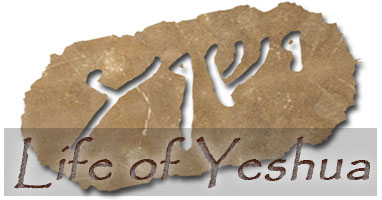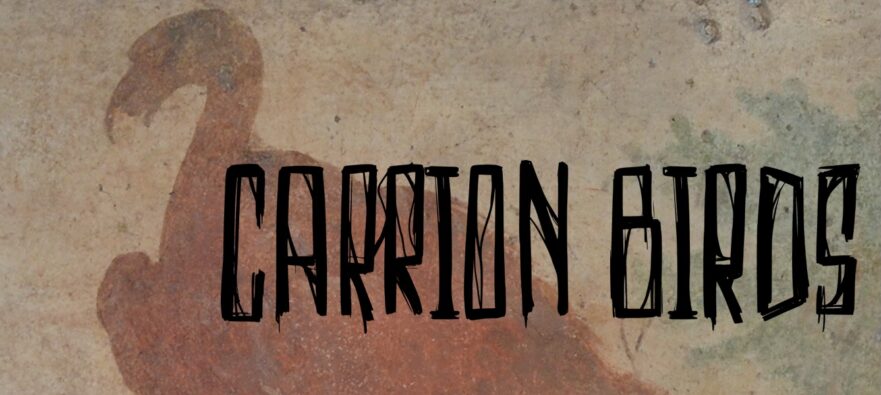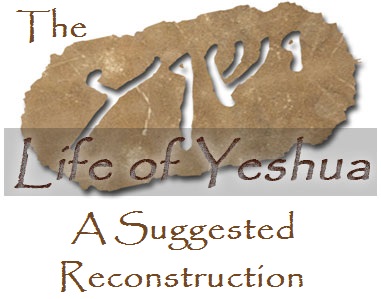How to cite this article:
David N. Bivin and Joshua N. Tilton, “Carrion Birds,” The Life of Yeshua: A Suggested Reconstruction (Jerusalem Perspective, 2022) [https://www.jerusalemperspective.com/23710/].
Matt. 24:28; Luke 17:37
(Huck 184, 218; Aland 235, 291; Crook 284, 331)[53]
Updated: 13 February 2025
אֵיכָן הַפֶּגֶר שָׁם יֵאָסֵף הָעַיִט
“Where the carcass is, there the carrion birds assemble.[54]
| Table of Contents |
|
3. Conjectured Stages of Transmission 5. Comment 8. Conclusion |
Reconstruction
To view the reconstructed text of Carrion Birds click on the link below:
Premium Members and Friends of JP must be signed in to view this content.
If you are not a Premium Member or Friend, please consider registering. Prices start at $5/month if paid annually, with other options for monthly and quarterly and more: Sign Up For Premium
Conclusion
In Carrion Birds Jesus portrayed the calamity in store for his generation in bleak, apocalyptic terms: his contemporaries would be the fulfillment of the warning that the carrion birds’ settling on Abraham’s sacrifices in Gen. 15:11 had symbolized.
 Click here to return to The Life of Yeshua: A Suggested Reconstruction main page.
_______________________________________________________
Click here to return to The Life of Yeshua: A Suggested Reconstruction main page.
_______________________________________________________

- [1] On this pre-synoptic collection of sayings relating to the Son of Man, see Days of the Son of Man, under the subheading “Story Placement.” ↩
- [2] Scholars who favor Matthew’s placement of Carrion Birds include Creed (221), Fitzmyer (2:1173), Kloppenborg (156), Nolland (Luke, 2:862), Catchpole (252), Bovon (2:514) and Wolter (2:313). See also Heinz O. Guenther, “When ‘Eagles’ Draw Together,” Forum 5.2 (1989): 140-150, esp. 145; Roger David Aus, “The Messiah as a Vulture in Matt 24:28 // Luke 17:37b,” in his My Name Is “Legion”: Palestinian Judaic Traditions in Mark 5:1-20 and Other Gospel Texts (Lanham, Md.: University Press of America, 2003), 289-302, esp. 289, 298, 301. ↩
- [3] Scholars who favor Luke’s placement of Carrion Birds include Manson (Sayings, 147), Bundy (391 §302) and Gundry (Matt., 486-487). Taylor was somewhat inclined to accept Luke’s placement of Carrion Birds, but remained undecided. See Vincent Taylor, “The Original Order of Q,” in New Testament Essays: Studies in Memory of Thomas Walter Manson (ed. A. J. B. Higgins; Manchester: Manchester University Press, 1959), 246-269, esp. 263. ↩
- [4] Kloppenborg (156) admitted that the redactional quality of the first half of Luke 17:37 does not in itself prove that Luke’s location of Carrion Birds is also secondary. ↩
- [5] See Wolter, 2:313. ↩
- [6] As we have discussed elsewhere, we believe it was the Anthologizer’s insertion of Like Lightning into the collection of Son of Man sayings now found in Luke 17 that gave an eschatological coloring to the entire collection. The original core of the collection did not concern the eschaton but the near term, during which Jesus, in his role as the Son of Man, served as a sign of destruction (at the hands of the Romans) for his generation. See Days of the Son of Man, under the “Story Placement” subheading. ↩
- [7] See Montefiore, TSG, 2:313. ↩
- [8] See Kloppenborg, 162. According to the first-century C.E. philosopher Cornutus, eagles (as distinct from vultures) were known for their swiftness:
ἱερὸς δ᾽ ὄρνις αὐτοῦ ἀετὸς λέγεται εἶναι διὰ τὸ ὀξύτατον τοῦτο τῶν πτηνῶν εἶναι.
The eagle [ἀετὸς] is said to be his [i.e., Zeus’—DNB and JNT] sacred bird because this is the swiftest of birds. (Cornutus, Greek Theology §9 [ed. Boys-Stones, 62-63])
Text and translation according to George Boys-Stones, ed. and trans., L. Annaeus Cornutus: Greek Theology, Fragments, and Testimonia (Atlanta: SBL Press, 2018). ↩
- [9] See McNeile, 351. ↩
- [10] See Creed, 221. ↩
- [11] See Guenther, “When ‘Eagles’ Draw Together,” 142. Cf. Montefiore, TSG, 2:313. ↩
- [12] O’Day points out this weakness of the “proverb” explanation. See Gail R. O’Day, “‘There the ? Will Gather Together’ (Luke 17:37): Bird-Watching as an Exegetical Activity,” in Literary Encounters with the Reign of God (ed. Sharon H. Ringe and H. C. Paul Kim; London: T&T Clark, 2004), 288-303, esp. 294. ↩
- [13] Although Ehrhardt adduced many instances of the image of vultures with corpses being alluded to in ancient sources, he failed to produce a single instance of the use of a proverb pertaining to vultures and corpses. See Arnold A. T. Ehrhardt, “Greek Proverbs in the Gospel,” Harvard Theological Review 46.1 (1953): 59-77, esp. 68-72.
Among the sources Ehrhardt cited are:
κατατέτακται δὲ εἰς σῖτα γυψίν· οἶδεν δὲ ἐν ἑαυτῷ ὅτι μένει εἰς πτῶμα.
But he [i.e., a tyrant (cf. Job 15:20)—DNB and JNT] has been appointed as grain for vultures [γυψίν], and he knows in himself that he is about to be a corpse [πτῶμα]. (Job 15:23)
γῦπα δ᾽ ἱερόν φασιν αὐτοῦ ὄρνιν εἶναι διὰ τὸ πλεονάζειν ὅπου πότ᾽ ἂν πτώματα πολλὰ ἀρηΐφθορα ᾖ.
The vulture [γῦπα] is said to be the bird sacred to him [i.e., the god Ares—DNB and JNT] because of their abundance wherever there are a lot of battle-slain corpses [πτώματα]. (Cornutus, Greek Theology §21 [ed. Boys-Stones, 98-99])
Amico aliquis aegro adsidet: probamus. At hoc hereditatis causa facit: vultur est, cadaver expectat.
When people sit by the bedsides of their sick friends, we honour their motives. But when people do this for attaining a legacy, they are like vultures [vultur] waiting for carrion [cadaver]. (Seneca, Epistle 95:43)
Text and translation according to Richard M. Gummere, Seneca: Ad Lucilium Epistulae Morales (Loeb; 3 vols.; New York: G. P. Putnam’s Sons, 1925), 3:86-87.
cuius vulturis hoc erit cadaver?
To what vulture [vulturis] shall this corpse [cadaver] belong? (Martial, Epigrams 6:62)
Text and translation according to Walter C. A. Ker, Martial: Epigrams (Loeb; 2 vols.; New York: G. P. Putnam’s Sons, 1919), 1:396-397.
οὐκ ἐγὼ ἔλεγον ὅτι θᾶττον τοὺς γῦπας ἕωλος νεκρὸς ἐν φανερῷ κείμενος ἢ θέαμά τι τῶν παραδόξων Τιμόλαον διαλάθοι, κἂν εἰς Κόρινθον δέοι ἀπνεωστὶ θέοντα ἀπιέναι διὰ τοῦτο;
Didn’t I say that it was easier for vultures to miss a stinking corpse in the open than for Timolaus to miss an odd sight, even if he had to run off to Corinth for it without a pause for breath? (Lucian, The Ship §1)
Text and translation according to A. M. Harmon, K. Kilburn and M. D. Macleod, Lucian (Loeb; 8 vols.; Cambridge, Mass.: Harvard University Press, 1913-1967), 6:430-431.
γὺψ νεκρῷ πολέμιος. ἐσθίει γοῦν ἐμπεσὼν ὡς ἐχθρὸν καὶ φθλάττει τεθνηξόμενον. καὶ μέντοι καὶ ταῖς ἐκδήμοις στρατιαῖς ἕπονται γῦπες, καὶ μάλα γε μαντικῶς ὅτι ἐς πόλεμον χωροῦσιν εἰδότεσ, καὶ ὅτι μάχη πᾶσα ἐργάζεται νεκρούς, καὶ τοῦτο ἐγνωκότες.
The Vulture is the dead body’s enemy. At any rate it swoops upon it as though it were an adversary and devours it, and watches a man who is in the throes of death. Vultures even follow in the wake of armies in foreign parts, knowing by prophetic instinct that they are marching to war and that every battle provides corpses, as they have discovered. (Aelian, On the Characteristics of Animals 2:46)
Text and translation according to A. F. Scholfield, Aelian: On the Characteristics of Animals (Loeb; 3 vols.; Cambridge, Mass.: Harvard University Press, 1958-1959), 1:144-145.
In addition, we note the following example (cited in Boring-Berger-Colpe, 230):
καὶ καθάπερ οἱ γῦπτες ἐπὶ τὰς ὀσμὰς τῶν διεφθορότων σωμάτων φέρονται, τῶν δὲ καθαρῶν καὶ ὑγιαινόντων αἴσθησιν οὐκ ἔχουσιν, οὕτω τὰ νοσοῦντα τοῦ βίου καὶ φαῦλα καὶ πεπονθότα κνεῖ τὸν ἐχθρόν, καὶ πρὸς ταῦθ᾽ οἱ μισοῦντες ᾄττουσι καὶ τούτων ἅπτονται καὶ σπαράττουσι.
And just as vultures [οἱ γῦπτες] are drawn to the smell of decomposed bodies [σωμάτων], but have no power to discover those that are clean and healthy, so the infirmities, meannesses, and untoward experiences of life rouse the energies of the enemy, and it is such things as these that the malevolent pounce upon and tear to pieces. (Plutarch, Moralia: How to Profit By One’s Enemies §3 [87D])
Text and translation according to Frank Cole Babbit et al., trans., Plutarch’s Moralia (Loeb; 16 vols.; Cambridge, Mass.: Harvard University Press, 1927-2004), 2:10-11.
Topel noted that “many exegetes speak of vultures being drawn to the carcass by scent. Old world vultures, unlike new world Cathartidae, have no sense of smell; they find the carcass by sight.” However, Plutarch’s remarks show that the mistake, so common among modern commentators, is an ancient one. See John Topel, “What Kind of a Sign Are Vultures? Luke 17,37b,” Biblica 84.3 (2003): 403-411, esp. 405 n. 21. ↩
- [14] See Warren Carter, “Are There Imperial Texts in the Class? Intertextual Eagles and Matthean Eschatology as ‘Lights Out’ Time for Imperial Rome (Matthew 24:27-31),” Journal of Biblical Literature 122.3 (2003): 467-487, esp. 470; Steven L. Bridge, ‘Where the Eagles are Gathered’: The Deliverance of the Elect in Lukan Eschatology (Sheffield: Sheffield Academic Press, 2003), 58-65; O’Day, “‘There the ? Will Gather Together,’” 288-303. ↩
- [15] Cf., e.g., Aus, “The Messiah as a Vulture in Matt 24:28 // Luke 17:37b,” 293-295. ↩
- [16] Vultures are the birds mentioned last in Job 39:27. This, together with the description of the bird in question being found with the dead, would naturally lead a Greek reader to suppose that Job 39:30 referred to vultures rather than eagles. See Carter, “Are There Imperial Texts in the Class?” 470. Indeed, it is probably the depiction of the nesher seeking out the bodies of the slain that induced the LXX translators to add vultures to Job 39:27, since they knew that this behavior was not appropriate for eagles. See Bridge, ‘Where the Eagles are Gathered,’ 64-65; O’Day, “‘There the ? Will Gather Together,’” 292-293. ↩
- [17] According to Gundry (Use, 88), “Mt and Lk supply οἱ ἀετοί from the preceding context in Job. Their (ἐπι)συναχθήσονται supplies the missing verb in the Hebrew and completely disagrees with the LXX, according to which the carcasses are found by the vultures.” In other words, Jesus’ saying in Carrion Birds resembles neither the Hebrew nor the Greek text of Job 39:30. Why then maintain, as Gundry does, that Jesus’ saying has any connection to Job 39:30? ↩
- [18] In our opinion, Carter has made an excellent attempt to make sense of Carrion Birds in its Matthean context. See Carter, “Are There Imperial Texts in the Class?” 467-487. Carter does not, however, address the redactional character of the eschatological discourse of Matthew 24 in which Carrion Birds appears. The author of Matthew used Mark 13’s eschatological discourse as a framework upon which to build his own more expansive discourse by inserting non-Markan materials at points he found to be appropriate. The author of Matthew’s method of constructing his eschatological discourse does not give us confidence that he preserved Carrion Birds in its original context. ↩
- [19] See Sign-Seeking Generation, Comment to L39. ↩
- [20] We have, in any case, seen that the evidence for a proverb about corpses and vultures is scarce and that an allusion to Job 39:30 is strained. ↩
- [21] 4 Ezra 3:13-14 alludes to the tradition of apocalyptic interpretation of Gen. 15. See Michael E. Stone, Fourth Ezra (Hermeneia; Minneapolis: Fortress, 1990), 71. ↩
- [22] On ancient Jewish apocalyptic interpretations of the covenant between the pieces, see Ginzberg, 1:198-201. See also Michael E. Stone, “Apocalyptic Literature,” in Jewish Writings of the Second Temple Period (CRINT II.2; ed. Michael E. Stone; Philadelphia: Fortress, 1984), 383-441, esp. 416. ↩
- [23] Cf., e.g., Mechilta de-Rabbi Ishmael, BaḤodesh §9 (ed. Lauterbach, 2:339). ↩
- [24] An amalgamation of sometimes conflicting apocalyptic interpretations of the covenant of the pieces is found in the following midrash:
וירד העיט על הפגרים . אלו עופות שדורסין: וישב אותם אברם. הפריחן מעליהן: ד″א קחה לי עגלה משולשת. זו בבל...ועז משולשת. זה יון...ואיל משולש. זו מדי...ותור, זו אדום...וגוזל. אלו ישראל...ולמה נקרא גוזל, שאלו ד′ מלכיות גוזלין את ישראל: ויבתר אותם בתוך. כדי להכחישם: ויתן איש בתרו. שאין מלכות נוגעת בחברתה אפילו כמלוא נימה: ואת הצפור לא בתר. זו הגוזל, כדי שיהיה כח לישראל לקבל גזירותיהם: וירד העיט על הפגרים . זה דוד בן ישי שנקרא עיט, שנאמר העיט צבוע נחלתי לי: וישב אותם אברם. הפריחן אברהם כדי שלא יהיה להם חלק לעולם הבא: ויהי השמש לבוא. זה משיח בן דוד שנקרא שמש, שנאמר וכסאו כשמש נגדו: ותרדמה נפלה על אברם. עד שיבוא המשיח יהיו לישראל כאילו רדומים ביניהם: והנה אימה. זו מלכות אדום...חשיכה זו יון... גדולה. זו מלכות מדי...נופלת עליו. זו בבל...ארבעה דברים הראה הקב″ה לאברהם, תורה וקרבנות ומלכיות וגיהנם. תורה מנין, שנאמר ולפיד אש. קרבנות, קחה לי עגלה משולשת. גיהנם, תנור עשן. מלכיות, אימה חשיכה, אמר לו כל זמן שבניך מתעסקים בתורה ובמצות ניצולים מגיהנם וממלכיות
And the carrion birds descended on the carcasses [Gen. 15:11]. These are birds that attack [their prey—DNB and JNT]. And Abram drove them away [Gen. 15:11]. He chased them away from the carcasses. Another interpretation: Take for me a three-year-old calf [Gen. 15:9]—this is Babylon.... And a three-year-old goat [Gen. 15:9]—this is Greece.... And a three-year-old ram [Gen. 15:9]—this is Media.... And a dove [Gen. 15:9]—this is Edom [i.e., Rome—DNB and JNT].... And a young pigeon [Gen. 15:9]—this is Israel.... And why is Israel called a young pigeon? Because these four empires despoil Israel. And he cut them in two [Gen. 15:10]—in order to curtail them. And the carrion birds descended on the carcasses [Gen. 15:11]—this is David son of Jesse, who is called a carrion bird, as it is said, Is the painted carrion bird my inheritance? [Jer. 12:9]. And Abram drove them away [Gen. 15:11]—Abraham chased them away so that they would not have a portion in the world to come. And the sun set [Gen. 15:12]—this is the Messiah the son of David, who is called the sun, as it is said, And his throne is like the sun opposite him [Ps. 89:37]. And deep sleep fell upon Abram [Gen. 15:12]—before the Messiah comes it will be for Israel as though they were fast asleep among them. And behold! Dread [Gen. 15:12]—this is the empire of Edom [i.e., Rome—DNB and JNT].... Darkness [Gen. 15:12]—this is Greece.... Great [Gen. 15:12]—this is the empire of Media.... Fell upon him [Gen. 15:12]—this is Babylon.... Four things did the Holy One, blessed be he, show to Abraham: the Torah, and sacrifices, and the empires, and Gehenna. Torah: how so? Because it is said, and a fiery torch [Gen. 15:17]. Sacrifices: [how so? Because it is said,] Take for me a three-year-old calf [Gen. 15:9]. Gehenna: [how so? Because it is said,] a smoking oven [Gen. 15:17]. The empires: [how so? Because it is said,] Dread, darkness [Gen. 15:12]. He [i.e., God—DNB and JNT] said to him [i.e., Abraham—DNB and JNT], “As long as your children occupy themselves with Torah and the commandments they will be delivered from Gehenna and the Empires.” (Midrash Aggadah, Lech Lecha [ed. Buber, 1:33-34])
Text according to Salomon Buber, ed., Agadischer Commentar zum Pentateuch nach einer Handschrift aus Aleppo (2 vols.; Vienna: Druck und Verlag, 1894).
The presence of conflicting interpretations—e.g., that the carrion birds represent the foreign empires and that the carrion birds represent King David (or the Messiah)—demonstrates that the individual elements presented in this midrash are more ancient than their amalgamation. ↩ - [25] For instance, in a version of Deuteronomy Rabbah we read the following:
עליהם עוף השמים ישכון אלו המלכיות שהן משעבדות בישראל, שנא′ וירד העיט על הפגרים ואע″פ שהן משעבדות בהן, מתוך צרתן ומתוך שעבודם הן מקלסין להקב″ה
Upon them the birds of the sky roost [Ps. 104:12]. These are the kingdoms that subdue Israel, as it is said, The carrion birds descended upon the carcasses [Gen. 15:11]. But although they subdue them, in the midst of their trials and in the midst of their enslavement they praise the Holy One, blessed be he. (Deut. Rab., VaEtḥanan [ed. Liebermann, 66])
Text according to Saul Liebermann, ed., Midrash Debarim Rabbah (2d ed.; Jerusalem: Wahrmann, 1964). ↩
- [26] The Apocalypse of Abraham is now extant only in Slavonic and Romanian versions, but it once existed in Greek and was probably translated from a Hebrew or Aramaic original. On the Apocalypse of Abraham, see Stone, “Apocalyptic Literature,” 415-418. ↩
- [27] Thus, in Midrash HaGadol we read:
וירד העיט על הפגרים...זו מלכות אדום שדשה את ישראל ופיזרה אותן ועשת אותן פגרים מתים
The carrion birds descended upon the carcasses [Gen. 15:11].... This is the empire of Edom [i.e., Rome—DNB and JNT], which trampled Israel and scattered them and made them dead corpses. (Midrash HaGadol to Gen. 15:11 [ed. Schechter, 1:235])
Text according to Solomon Schechter, ed., Midrash Hag-Gadol (Cambridge: Cambridge University Press, 1902).
In the Apocalypse of Abraham the carrion birds of Gen. 15:11 are equated with Azazel, one of the names of Satan (Apoc. Abr. §13). According to some apocalyptic traditions, Satan was regarded as the angelic prince who presided over the Roman Empire. See Joshua N. Tilton, “Like Lightning from Heaven (Luke 10:18): Jesus’ Apocalyptic Vision of the Fall of Satan.” ↩
- [28] Cf. Lightfoot, 2:319; Gill, 7:293. ↩
- [29] According to Lindsey’s hypothesis, Anth. was the only source of Matthew’s non-Markan Double Tradition pericopae. ↩
- [30] On verbal identity in Lukan-Matthean Double Tradition pericopae as an indicator of the sources used by the authors of Luke and Matthew, and for the exact figures of verbal identity in Carrion Birds, see LOY Excursus: Criteria for Distinguishing Type 1 from Type 2 Double Tradition Pericopae. ↩
- [31] In Luke, each of these pericopae appear in Luke 17; in Matthew, each of these pericopae appear in Matt. 24. ↩
- [32] See Bundy, 391 §302; Fitzmyer, 2:1173; Kloppenborg, 156; Nolland, Luke, 2:857; Davies-Allison, 3:354 n. 180; Bovon, 2:525; Wolter, 2:313. ↩
- [33] If the first half of Luke 17:37 had been based on a Hebrew source, we would have expected to find καὶ ἀποκριθέντες εἶπαν (kai apokrithentes eipan, “and answering they said”), as, in fact, we do in Matt. 21:27 (cf. Mark 11:33); 26:66; Luke 9:19. ↩
- [34] See Robert L. Lindsey, “From Luke to Mark to Matthew: A Discussion of the Sources of Markan 'Pick-ups' and the Use of a Basic Non-canonical Source by All the Synoptists,” under the subheading “An Examination of the Editorial Activity of the First Reconstructor,” Comment to L84-86. ↩
- [35] Cf. Guenther, “When ‘Eagles’ Draw Together,” 140; Davies-Allison, 3:354. ↩
- [36] See Ehrhardt, “Greek Proverbs in the Gospel,” 68. ↩
- [37] See Plummer, Luke, 410; Harnack, 107; Cadbury, Style, 187; Gundry, Use, 88; Davies-Allison, 3:354; Bovon, 2:524. ↩
- [38] See Hatch-Redpath, 2:1239. ↩
- [39] In LXX σῶμα occurs as the translation of פֶּגֶר in Gen. 15:11; 4 Kgdms. 19:35; Isa. 37:36. ↩
- [40] Cf. Bridge, ‘Where the Eagles are Gathered,’ 53. ↩
- [41] See Sign-Seeking Generation, Comment to L42-43; Days of the Son of Man, Comment to L10; Cadbury, Style, 146-147. Cf. Bridge, ‘Where the Eagles are Gathered,’ 52. ↩
- [42] See Davies-Allison, 3:354. On the author of Luke’s general preference for compound verbs, see Cadbury, Style, 166. ↩
- [43] We have reconstructed συνάγειν with הִכְנִיס in Yeshua’s Discourse on Worry, L16, and Darnel Among the Wheat, L34. ↩
- [44] See Hatch-Redpath, 2:1307-1309. ↩
- [45] See Dos Santos, 14. ↩
- [46] See G. D. Driver, “Birds in the Old Testament I. Birds in Law,” Palestine Exploration Quarterly 87.1 (1955): 5-22, esp. 5. ↩
- [47] Cf. Aus, “The Messiah as a Vulture in Matt 24:28 // Luke 17:37b,” 290-291. ↩
- [48] In this regard we are in agreement with Topel, “What Kind of a Sign Are Vultures? Luke 17,37b,” 405-406. ↩
- [49] The eagle as a symbol of Rome was well established in the first century in the land of Israel. King Herod’s erection of a golden eagle at the entrance to the Temple aroused sharp opposition not only because of the Jewish avoidance of figural art, but also—although Josephus does not say this—because it was a symbol of the imperial power (J.W. 1:650-651; Ant. 17:151-155). In 4 Ezra 11:1-12:39 an eagle symbolizes the Roman Empire in an apocalyptic vision. On the Roman legions’ ownership of the eagle as their symbol, see Jos., J.W. 3:123. On the eagle as a symbol of Rome, see further Carter, “Are There Imperial Texts in the Class?” 474-476. ↩
- [50] Incidentally, the Greek word ἀετός (aetos) sounds not unlike the Hebrew term עַיִט (‘ayiṭ). It was not unknown for ancient translators to allow homophony (like-soundingness) to influence their lexical choices. See Emmanuel Tov, “Loan-Words, Homophony, and Transliteration in the Septuagint,” in his The Greek and Hebrew Bible: Essays on the Septuagint (Leiden: Brill, 2014), 165-182, esp. 170-174. Aus (“The Messiah as a Vulture in Matt 24:28 // Luke 17:37b,” 291) suggested that ἀετός may even be philologically related to עַיִט. ↩
- [51]
Carrion Birds Luke’s Version Anthology’s Wording (Reconstructed) καὶ ἀποκριθέντες λέγουσιν αὐτῷ ποῦ κύριε ὁ δὲ εἶπεν αὐτοῖς ὅπου τὸ σῶμα ἐκεῖ καὶ οἱ ἀετοὶ ἐπισυναχθήσονται ὅπου τὸ πτῶμα ἐκεῖ συναχθήσονται οἱ ἀετοί Total Words: 18 Total Words: 7 Total Words Identical to Anth.: 5 Total Words Taken Over in Luke: 5 Percentage Identical to Anth.: 27.78% Percentage of Anth. Represented in Luke: 71.43% ↩
- [52]
Carrion Birds Matthew’s Version Anthology’s Wording (Reconstructed) ὅπου ἐὰν ᾖ τὸ πτῶμα ἐκεῖ συναχθήσονται οἱ ἀετοί ὅπου τὸ πτῶμα ἐκεῖ συναχθήσονται οἱ ἀετοί Total Words: 9 Total Words: 7 Total Words Identical to Anth.: 7 Total Words Taken Over in Matt.: 7 Percentage Identical to Anth.: 77.78% Percentage of Anth. Represented in Matt.: 100.00% ↩
- [53] For abbreviations and bibliographical references, see “Introduction to ‘The Life of Yeshua: A Suggested Reconstruction.’” ↩
- [54] This translation is a dynamic rendition of our reconstruction of the conjectured Hebrew source that stands behind the Greek of the Synoptic Gospels. It is not a translation of the Greek text of a canonical source. ↩





